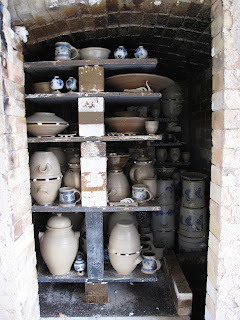The kiln firing went well, but there are definitely some noticeable kinks I need to work out. Anyone with wood-firing experience, I would greatly appreciate your input. I'm thinking to switch up my stacks - put the larger set
of shelves in the back where there seems to get more heat and ash and
the shorter stack in the front on the side. I'm afraid to put glazes on
the pieces in the front corner since this has been my coolest area
because the ash will cling to the glaze and ruin the pots.
 |
| Brown ash run that was a little matte |
The last time I fired the heavily salted mugs had a green surface. This time around the ash runs had a brown color that was a little matte. The salt I used this time was cattle salt from the feed store, but is
supposed to be pure salt. So I wonder whether my using sea salt in the last couple of firings made any difference. Has anyone else noticed a difference in their salt choices? Table salt vs. cattle salt? I opted for the cattle salt because it was cheaper and came in large amounts. That, and it doesn't have scary additives like prussiate of soda which turns into cyanide.
 |
| Coating on the ash on the shelf |
 |
| Ash settled in the bottom of an ash-glazed dish that did not flux out or melt |
 |
| Dry ash on the edge of a decorated dish |
The ash is still piling up even though I brought the shelves several inches away from the door and the wall with both sets of shelves. The biggest problem I have been having is that the ash doesn't melt down in all places, and it is settling as dry ash on some of my glazed surfaces. I'm afraid that crash cooling the kiln has been having this effect on the ash as it is not giving it enough time to heat up and soak. This most recent firing cooled as slowly as the other firings (about 2 days).
 |
| Spotting in the glaze |
 |
| Glaze separation/split in the bottom of a dish |
The other issue is that my ash glaze liner has been appearing to be thin (but I have skimmed water and it goes on thick) and in this firing showed spots from reduction or cooling and the glaze split in the base of a few pieces - not the clay, just the glaze. If I'm only firing to cone 10/11 should I not use an ash glaze as a liner? Do ash glazes inherently need a higher temperature in order to truly flux out?
So here are my questions:
Should I salt earlier in the firing and then soak the kiln to cone 11 in order to flux out the ash?
Should I not crash cool the kiln?
Should I insulate the kiln even more in order for it to take longer to cool (more than 2 days)?
Why is the ash not melting out on the glazes or remaining in dry patches on pots?
Should I use a different liner glaze? If so, does anyone have any recommendations that isn't an ash base for single-firing?



















































